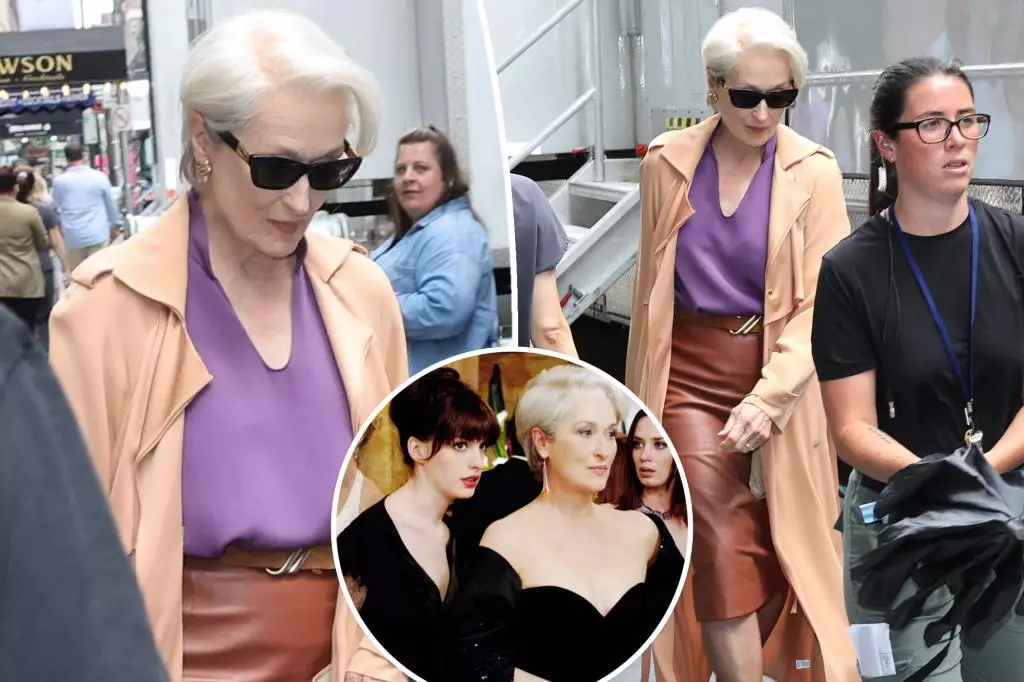The news of Meryl Streep reprising her role as Miranda Priestly in “The Devil Wears Prada 2” marks a significant milestone in Hollywood’s culture of rebooting beloved franchises. Streep’s portrayal of the ruthless but fascinating fashion editor became an instant classic, embedding her deeply into the pop culture consciousness. Spotted on the set in New York City, her return is more than just a nostalgic callback—it’s a testament to her versatility and enduring superstar appeal. The meticulous attention to her appearance—icy white pixie cut, stylish tan trench, and elegant accessories—reaffirms her commitment to authenticity, making her portrayal as compelling today as it was over 15 years ago.
Streep’s resilience in stepping into a role that many actors might shy away from reveals her dedication to challenging herself as an artist. Despite her admitted dissatisfaction during the original filming, her return suggests a newfound perspective—perhaps one of pride in how her character has evolved into a cultural icon. The film industry’s tendency for reboots and sequels often walks a fine line between refreshment and repetition, but with Streep on board, expectations for this installment are elevated. Her portrayal embodies a complex blend of power, vulnerability, and the relentless pursuit of perfection—traits that continue to resonate in today’s ever-evolving professional landscape.
The Dynamic Shift in the Fashion and Media Landscape
“The Devil Wears Prada 2” promises to explore the shifting paradigms of the magazine and fashion industries. The original film captured a moment in time when print media still held sway, but the sequel is set against the backdrop of decline and transformation. According to reports, Priestly—once the ultimate symbol of authority—must now navigate a much-changed landscape where digital innovation and streaming have dismantled traditional publishing empires. It’s a compelling narrative that reflects broader societal shifts: the emergence of new power structures, the decline of old guard institutions, and the importance of adaptability.
The film’s narrative seems poised to place Priestly at the crossroads of nostalgia and reinvention. Her rivalry with Emily, now a high-powered executive herself, symbolizes the fierce competition and evolving alliances within the luxury and media worlds. The inclusion of fresh faces like Lucy Liu and Justin Theroux signals a merging of different worlds, blending veteran star power with a contemporary cast to appeal to a new generation of viewers who are digital natives.
This storyline offers more than entertainment; it’s a reflection of real-world industry shifts. The fashion industry, long a cultural mirror of societal change, is increasingly layered with new voices and perspectives. The film’s exploration of high-powered women navigating this uncharted terrain can serve as a powerful commentary on resilience and strategic adaptability in business and life.
Anticipating a Cultural Phenomenon
With the original film’s success still freshly present in public memory, expectations for “The Devil Wears Prada 2” are sky-high. The ongoing social media buzz—particularlyAnne Hathaway’s teasing TikTok—fuel anticipation and create a sense of community among fans and new viewers alike. Hathaway’s nod to the classic cerulean sweater demonstrates how the film continues to influence fashion trends and pop culture references, effectively cementing its status as a cultural touchstone.
Moreover, the casting of notable newcomers like Kenneth Branagh, who will play Priestly’s husband, promises a compelling dynamic that could add dimensions of personal struggle and family life to the narrative. This suggests that the sequel isn’t merely about the glitz and glamour—it will delve deeper into the human elements behind the glamorous facade. The strategic infusion of humor, high fashion, and keen social commentary has the potential to elevate this film into much more than just a sequel; it could become an insightful reflection of contemporary society’s ongoing transformation.
While critics sometimes view Hollywood’s reboot culture with skepticism, the combination of a talented cast, a rich storyline rooted in industry evolution, and Meryl Streep’s legendary performance creates a unique opportunity for this sequel to break the mold. If executed with authenticity and wit, “The Devil Wears Prada 2” could reaffirm the franchise’s relevance and demonstrate that even in a rapidly changing world, timeless themes of power, ambition, and reinvention remain endlessly captivating.

